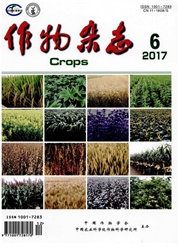

 中文摘要:
中文摘要:
以转IrrE基因与非转基因甘蓝型油菜为材料,用10%(w/V)PEG6000(聚乙二醇)进行了干旱胁迫实验,比较研究了转IrrE基因与非转基因甘蓝型油菜幼苗的耐受性应答情况。结果表明:转基因油菜植株含水量下降趋势小于非转基因油菜植株;转基因油菜植株叶绿素含量和荧光参数F0的上升趋势均明显大于非转基因油菜植株;转基因油菜植株的Fv/Fn值和可溶性蛋白含量均大于非转基因油菜植株,但丙二醛(MDA)含量小于非转基因油菜植株。以上结果从侧面证实了:在干旱胁迫下,转IrrE基因油菜植株较非转基因植株有更强的耐受能力;,柑基因作为一种转录调节因子,广泛参与了油菜幼苗对干旱胁迫的耐受性应答过程,增强了植株的耐旱能力。
 英文摘要:
英文摘要:
The tolerant responses of transgenic-IrrE and non-transgenic Brassica napus L. under drought stress induced by 10% (W/V) PEG 6000 (polyethylene glycol) was comparatively studied. The physiological index such as relative water content (RWC), chlorophyll content, chlorophyll fluorescence parameters Fo, Fv/Fm, the malondialdehyde (MDA) content and soluble protein contents were investigated. The results showed that the relative water content (RWC) and Fv/Fm of transgenic-lrrE and non-transgenic B. napus leaves decreased gradually, but the malondialdehyde (MDA) content, soluble protein contents, chlorophyll content and chlorophyll fluorescence parameters F0 all increased gradually. In a conclusion,transgenic-IrrE B. napus showed higher resistance to drought than non-transgenic B. napus. IrrE gene, as a transcription factor, participated in the processes of tolerance response to drought stress broadly, could increase the tolerance to drought stress in transgenic-IrrE B. napus.
 同期刊论文项目
同期刊论文项目
 同项目期刊论文
同项目期刊论文
 Effects of different NaCl concentration on the antioxidant enzymes in oilseed rape (Brassica napus L
Effects of different NaCl concentration on the antioxidant enzymes in oilseed rape (Brassica napus L Molecular Cloning and Characterization of a new Peroxidase Gene(OvRCI)from Orychophragmus violaceus.
Molecular Cloning and Characterization of a new Peroxidase Gene(OvRCI)from Orychophragmus violaceus. 期刊信息
期刊信息
